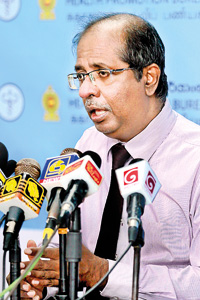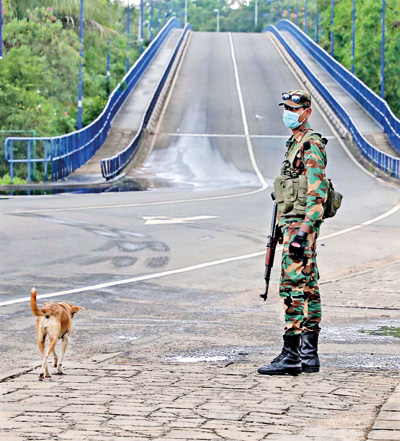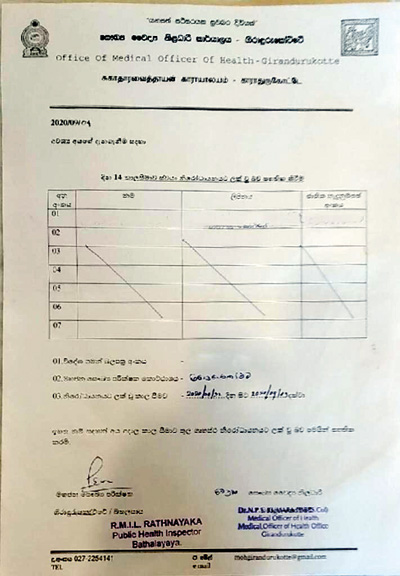News
Op Centre at Health Ministry to defuse newest cluster

Dr. Sudath Samaraweera. Pic by Sameera Weerasekera
An Operations Centre was established on Friday at the Health Ministry to act as a coordination mechanism among all sectors to respond speedily to the challenges posed by the latest Minuwangoda cluster with a garment factory as its nucleus.
The Minuwangoda cluster has not only affected the Gampaha district but has also spread its tentacles across the country.
Headed by Health Ministry Secretary Major-General Dr. Sanjeewa Munasinghe all stakeholders involved in battling the new coronavirus are represented at the Operations Centre, the Sunday Times learns, while a Technical Committee also based at the ministry has been functioning since the beginning of the COVID-19 pandemic in January, to provide technical guidance.
Currently, the other bodies which have as their focus, this pandemic that has swept through the world, are the National Operation Centre for Prevention of COVID-19 Outbreak (NOCPCO) headed by Army Commander Lieutenant General Shavendra Silva and the Presidential Task Force on COVID-19.
In a wide-ranging interview, the Sunday Times asked the Health Ministry’s Chief Epidemiologist, Dr. Sudath Samaraweera, about many concerns at the forefront of people’s minds.
To the question whether there is community transmission of the virus, he was specific that community transmission has not been established yet.
With many expressing worry over the holding of two public examinations (the Grade 5 Scholarship examination today and the Advanced Level examination starting tomorrow), Dr. Samaraweera allayed fears and said that the authorities know the children who would be sitting the exams.
“We know the count. The previous plan was for the Gampaha students to go to their schools to do the exams in a designated transport system. Now they are going to set up centres in Gampaha. There is no need to worry,” he said.
Referring to instances where some students may have attended large-scale tuition classes in Gampaha, he requested all those who did so to place themselves in self-quarantine, as children from all over the country may have come to these classes.
With regard to the Minuwangoda outbreak, Dr. Samaraweera said: “We think it will be present only for a short period, we are just at the beginning of the outbreak. When you look at the bigger picture, we feel the ‘second line’ has spread on a smaller scale.”
Earlier, he said that the viral load of the first 60-odd people confirmed as positive in the Minuwangoda cluster was very high and that indicates that it may have been caught early.
When the Sunday Times checked what this means, we learnt that the patients may have been detected early, with other experts explaining that as soon as a person gets infected there is a high viral load but as that person’s immune system responds or kicks-in to battle the invader-infection, the viral load begins to reduce.
“But it seems to be a very active cluster,” an expert said, pointing out that whether the virus affecting this cluster is a different strain can only be ascertained by carrying out genome sequencing of the virus.

Quarantine curfew in progress in Veyangoda
When asked not only about the Minuwangoda cluster but also the infections popping up outside the Gampaha district, Dr. Samaraweera said that other than three or four, all others have a link to that cluster. This may be due to factory workers sharing boardings, etc.
“Some of the other cases that were confirmed even if they didn’t seem to have a link, when they were thoroughly explored we could trace them back to something like going for a delivery. It takes time for us to find the link and there is no evidence that there is community transmission. It is only after we get the results from RT-PCR tests from the community, that we can decide whether there is community transmission or not,” he said.
Focusing on the ‘source’ of the infection which set off the Minuwangoda cluster, the Chief Epidemiologist said they are taking the case histories but the numbers are high (over 1,000) and it takes time. The possibilities for this outbreak could be the area’s proximity to the airport, an airport worker could have accidentally contracted the infection and it could have leaked. It could be from an airline crew member. It could be an undetected case that came from abroad. The woman who sought treatment at the Gampaha Hospital was not the first patient in this cluster as there were cases of people who had been having symptoms from September 20.
“We are carrying out contact-tracing,” he assured, explaining that ‘first contacts’ are those who have had direct exposure to a COVID-19 positive case, while ‘second contacts’ are those who have been in contact with the first contacts.
Was there a flaw in the quarantining process?
Dr. Samaraweera said that there could not have been a gap in the quarantining centres or in homes because the system is well-established.
However, he conceded that there may have been a slip-up or two like the Matara incident where 15 Russians walked out of the Mattala Rajapaksa International Airport (MRIA) and lodged in a beach resort which was not a designated hotel quarantine centre. “There were no similar cases,” he added.
RT-PCR tests
As of Friday, Sri Lanka has conducted a total of 320,000 RT-PCR tests since the start of the COVID-19 crisis.
Dr. Samaraweera said that on Thursday alone 6,000 RT-PCR tests were conducted in the light of the new cluster.
Bed-strength in state hospitals
Meanwhile, discussing the bed-strength in state hospitals, the Health Ministry’s National Coordinator for Disaster Management, Dr. Hemantha Herath told a media briefing on Friday morning that around 2,000 beds have been made ready.
“We don’t think it will exceed this capacity because the cases are contained. However, if the need arises we can increase the bed capacity to around 3,000,” he said.
When asked about beds in Intensive Care Units (ICUs) in state hospitals, Dr. Herath said that currently there are 200 which can be increased to 700, which are more than enough to face the current situation.
| Adhere to health measures Follow the basic health measures of prevention, was the strong plea, as the Health Ministry tightened its guidelines till October 31. “Everyone should wear a face-mask when leaving home, hand hygiene is essential as also social distancing in public places. All unnecessary travel and gatherings should be halted forthwith,” said Chief Epidemiologist Dr. Sudath Samaraweera. New guidelines till October 31 Some of the guidelines included no visits to prisons; closure of all universities, schools, tuition classes, pre-schools and daycare centres; halting of all parties (indoor, outdoor or beach parties); closure of pubs, bars, cinemas, theatres, casinos, night clubs, betting centres & spas; and banning of all public gatherings, carnivals & musical shows. Weddings and funerals though allowed are under tight restrictions with service providers and attendees being restricted to less than 50% of the capacity of the hall as also grocery stores, beauty/barber salons, gymnasiums, places of worship, dining-in restaurants, swimming pools, children’s parks & the zoo. Seating capacities on public transport and private taxi services have been restricted. Random testing by Gampaha doctors paved way to identify new cluster The country’s attention turned towards Minuwangoda when a 39-year-old supervisor at the factory of Brandix Apparel sought treatment for fever, cough and chest pain at the Gampaha Hospital. “We did random sampling and took an RT-PCR test. That’s how we caught the infection in this patient,” said Gampaha’s Consultant Respiratory Physician Dr. Bodhika Samarasekera. The patient had sought treatment at the Preliminary Care Unit (PCU) on September 30 and the doctors there had referred her to Dr. Samarasekera’s ward on suspicions that she was having pneumonia. There were no suspicions of COVID-19. A chest X-ray indicated there was no pneumonia and when she complained of chest pain, an ECG ruled out a heart issue. “But in the light of the COVID-19 pandemic and the airport being in our district, we have been alert and have been performing random sampling of those who come in from the community,” says Dr. Samarasekera, who with his Medical Officer, Dr. Manjula Nanayakkara, took the sample, sent it for testing and on October 2 discharged the patient as she was not sick. He says that this patient was probably not the first (index) patient in this cluster. But this is different to the Kandakadu cluster which was limited to those at the Treatment & Rehabilitation Centre, its staff and those who visited them. Kandakadu was contained. Here, people who were asymptomatic may have gone on trips, visited others’ homes not just in the area but all over the country. This is why there could be pockets of COVID-19 outside this area. Meanwhile, the Sunday Times learns from other sources that it had been on September 27 that another employee of the same factory had sought treatment for fever, cough and cold at a clinic run after hospital-hours by a doctor working at the Gampaha Hospital. She had returned on the 28th for further treatment but having got better come once again on the 30th to get a medical certificate. Now this doctor has tested positive and is in hospital, while health staff at the Gampaha Hospital who came into contact with him are in quarantine. “We don’t know how many Brandix staff came back to Sri Lanka,” says PHI Union The Public Health Inspectors’ (PHIs) Union said that it does not know how many Brandix staff arrived in Sri Lanka but there are fewer than 10 who were in Koggala for home quarantining and the supervision of the PHIs. “I do not know what happened to the others and there was no information provided to us about them,” said union Secretary M. Balasooriya, adding: “I am not putting any blame on anyone but I believe there should be proper coordination in a situation like this.” There is a document on social media that about 40 Brandix staff members who arrived from India are under their supervision but nothing of that sort has happened, he said. Mr. Balasooriya went onto say that there were questions raised as to whether the PHIs gave permission to Brandix employees who returned from India to enter the factories. “We responsibly say that we have not given such permission. We don’t know whether they visited the factories or not or what the issue is, but we have not given any permission.” |
| |
| ‘No Indian or foreign-returnees at our facilities’ The Sunday Times contacted Brandix Apparel Limited to answer some questions on email. Here are the questions and their answers:Please confirm that no Indians or foreign-returnees came to repair the air-conditioning at the Head Office, Minuwangoda factory or any other factory. Please confirm that no Indians or foreign-returnees came for any other work to these places. Please confirm that no imported material or other stuff, whether from India or elsewhere was used in the factories in Sri Lanka. All the returnees from India were Sri Lankan Executive cadre employees who had been expatriated to support with the management of our facilities in India. Further, we had not had any Indian or foreign-returnees at our facilities to repair air-conditioning or other work. Our facility in Minuwangoda does not use any fabric from India as already stated in our previous statement. Further, the Coronavirus can last only a few hours outside a carrier’s body. With raw material imports taking 10 – 20 days to reach Sri Lanka, the virus is unable to survive. Further, the closed containers reach very high temperatures during the travel period, during which the virus is once again unable to survive. Hence, during the import process, the virus is no longer effective for contamination. Is it true that Brandix is exporting face-masks to the USA? If so, what has been the fallout from the COVID-19 crisis that has surrounded the Minuwangoda factory? The face masks we produce at Minuwangoda are produced as an apparel accessory for our existing customers. We have halted production since the identification of the 1st COVID-19 positive employee at Minuwangoda. Did any Sri Lankan or other workers (of foreign origin) from any of the foreign factories (in Bangladesh, Singapore, United States, United Kingdom, Cambodia, Australia and Haiti) come to Sri Lanka for work in the past two months? No, this has not taken place. What were the health procedures followed at the Brandix factories in the light of COVID-19? If stringent safety precautions were followed, how was the third-party cleaning service contracted by BrandixMinuwangoda allowed to carry out cleaning processes at the factory when its staff was ill? (We refer to the video that has been on social media and which Brandix has addressed in the media release) All our facilities are instructed to follow the protocol for COVID-19 prevention in line with the health authorities. We are investigating on how the protocols have been inadequate in spite of what is in place. Our COVID-19 prevention process is a standard practice for both internal and external parties. The two contracted cleaning staff members had been requested to carry out the sanitation process required prior to the PCR testing scheduled for 5th October 2020, a requirement that was conducted under the supervision of the PHI present at the facility and in complete adherence to the COVID-19 prevention protocol that included wearing of hazmat suits. Was there a party in early September where Brandix employees gathered at any of the Brandix factories? Upon resuming our routine business post the closure during the COVID-19 lockdown phase earlier this year, we have been working tirelessly to sustain the limited number of orders received. As a general protocol, our factory management takes efforts to run employee engagement to boost morale and for team building purposes, hence we are investigating as to whether proper protocols had been followed. Did the Brandix management issue instructions to any of the factories (including Minuwangoda) for employees to come to work even if they were unwell? Did a Brandix General Manager on-site at Minuwangoda instruct 6 workers who had COVID-19 symptoms to go back to work on the factory floor? Brandix has a clear health and safety protocol and as a policy, we have directed all our facilities to follow the Ministry of Health protocol. However, we are thoroughly investigating on any failures in this regard and will share our learnings, and take the necessary action if found to be in violation.
All quarantine regulations followed Brandix has reiterated that all the passengers followed the Sri Lanka Government protocol for the prevention and control of COVID-19, which includes PCR testing and a 14-day mandatory quarantine at a government regulated quarantine facility, as well as the 14-day self-quarantine process done under the supervision of the respective PHIs. “Upon completion of the 14-day mandatory period at a government regulated quarantine facility, a certification signed by the Head of National Operation Centre for Prevention of COVID-19 and the Director General of Health Services is issued to each individual confirming the same. The passengers then underwent the 14-day self-quarantine process done under the supervision of the respective PHIs. Certificates in this regard were issued by the Office of Medical Officer of Health for the respective area, which is signed off by the respective Public Health Inspector and the Medical Officer of Health, confirming completion of the self-quarantine process for each passenger as well,” it states.
 Certification from Government Authorities - 22nd Sep - 6th Oct
 Certification from Office of Medical Officer of Health |

